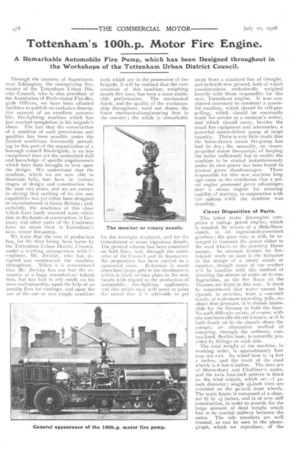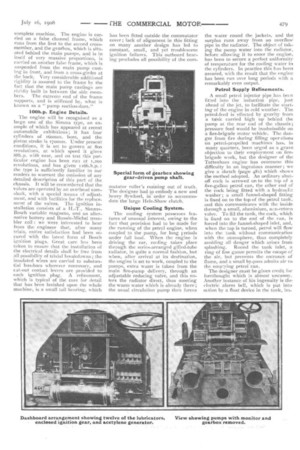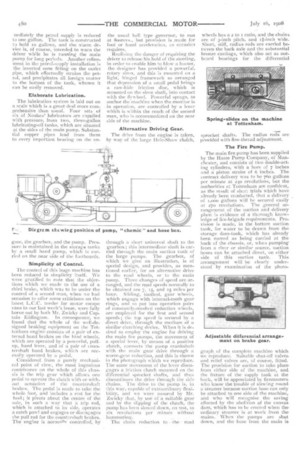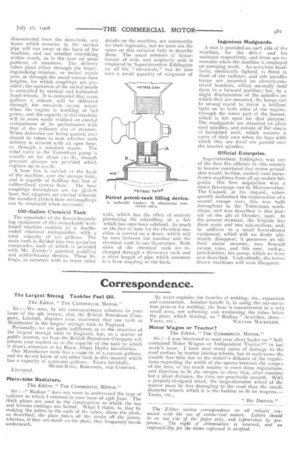Tottenham's 100h.p. Motor Fire Engine.
Page 18

Page 19

Page 20

Page 21

If you've noticed an error in this article please click here to report it so we can fix it.
A Remarkable Automobile Fire Pump, which has been Designed throughout in the Workshops of the Tottenham Urban District Council.
Through the courtesy of Superintendent Eddington, the enterprising firemaster of the Tottenham Urban District Council, who is also president of the Association of Professional Fire-Brigade Officers, we have been afforded facilities to publish an exclusive descriptive account of an excellent automobile, fire-fighting machine which has just reached completion in his brigade's shops. The fact that the construction of a machine of such pretensions and qualities has been possible under the limited conditions necessarily prevailing in this part of the organisation of a borough council fire-brigade, is no less exceptional than are the undoubted skill and knowledge of specific requirements which have been brought to bear upon the design. We understand that the machine, which we are now able to illustrate fully, has been in various stages of design and construction for the past two years, and we are correct in stating that nothing of its size and capabilities has yet either been designed or manufactured in Great Britain ; and, certainly, the machines of this class which have lately received some attention at the hands of constructors in Germany and other parts of the Continent have no mean rival in Tottenham's. new, motor fire-pump.
We learn that the cost of production has, for the time being, been borne by the Tottenham Urban District Council, under a working arrangement with it.; engineer, Mr. Zwicky, who has designed and constructed the machine
throughout. When it is 1-11!IIWT1 1 bored that Mr. Zwicky has not had the resources of a huge manufactory behind him, but has had to rely solely on his own craftsmanship, upon the help of an outside firm for castings, and upon the use of the one or two simple machine
tools which are in the possession of the brigade, it will be realised that the construction of this machine, weighing nearly five tons, has been a most creditable performance. The mechanical finish, and the quality of the workmanship throughout, need not shame the finest mechanical-engineering firm in the country ; the whole is remarkable for the foresight displayed, and for the embodiment of many ingenious details. The general scheme has been conceived on bold lines, and, through the enterprise of the Council and its firemaster, the proposition has been carried to a
successful .issue. Reference is made elsewhere (page 466} to the development which is likely to take place in the near future with regard to the production of automobile, fire-fighting appliances, and this article may well serve to point the moral that it Is advisable to get
away from a standard line of thought, and to break new ground, both of which considerations undoubtedly weighed heavily with those responsible for this new, Tottenham engine. It was considered necessary to construct a powerful machine, which should be self-propelling„ which should be constantly ready for service at a moment's notice, and which should carry, besides the usual fire equipment and accessories, a powerful motor-driven pump of large capacity. There is very little doubt that the horse-drawn steam fire-pump has had its day ; the necessity, on steampropelled motor fire-pumps, of keeping the boiler sufficiently hot to enable the machine to be started instantaneously under its own power has been found to possess grave disadvantages. Those responsible for this new machine long ago came to the conclusion that a petrol engine possessed great advantages over a steam engine for securing rapidity of starting, in conjunction with low upkeep while the machine was standing,
Clever Disposition of Parts.
This latest motee fire-engine comprises a rooh.p. petrol engine, which is coupled, by means of a Hele-Shaw clutch, to an ingeniously-contrived gearbox ; the gear can, at will, be arranged to transmit the power either to the road wheels or the powerful Haste pumps. An unusual feature for firebrigade work on land is the inclusion in the design of a rotary nozzle or monitor, though many of our readers will be familiar with this method of directing the stream of water on to conflagrations, as the fire floats on the Thames are fitted in this way. It must be remembered that water cannot be ejected, in practice, from a one-inch nozzle, at a pressure exceeding 701b., as, above that pressure, it is almost impossible for the .firemen to hold the hose. No such difficulty exists, of course, with this mechanically-dircted nozzle, as it is built firmly on to the chassis above the pumps; an alternative method of pumping, throughthe ordinary, canvas-lined, flexible hose, is naturally provided by fittings on each side.
The total weight of the machine, in working order, is approximately four tons ten cwt. Its wheel base is 14 feet 2 inches, and the track of the road wheels is 6 feet 6 inches. The tires are of Shrewsbury and Challiner's make, and the twin four-inch pattern is fitted on the hind wheels, which are cf 42inch diameter ; single 4t-inch tires are .nrovided on the 40-inch front wheels. The main frame is composed of a channel 61 by 21 inches, • and is-of very stiff construction, in order to provide for the large amount of dead weight which has to be carried midway between the axles. The side members are well trussed, as cart be seen in the photograph, which we reproduce, of the
complete machine. The engine is carried on a false channel frame, which runs from the first to the second crossmember, and the gearbox, which is situated behind the main pumps, and is in itself of very massive proportions, is carried on another false frame, which is suspended from the main pump casting in front, and from a cross-girder at the back. Very considerable additional rigidity is assured to the frame by the fact that the main pump castings are rktidly built in between the side members. The extreme end of the frame supports, and is stiffened by, what is known as a " pump suction-dam."
100h.p. Engine Details.
The engine will be recognised as a large one of the Simms type, an example of which has appeared at recent automobile exhibitions ; it has four cylinders of 16omm. bore, and the piston stroke is 170mm. Under present conditions, it is set to govern at Soo revolutions, at which speed it gives 88h.p. with ease, and on test this particular engine has been run at 1,200
revolutions, and has given : the type is sufficiently familiar to our readers to warrant the omission of any detailed description of this part of the chassis. It will be remembered that the valves are operated by an overhead camshaft, with a special means of adjustment, and with facilities for the replacement of the valves. The ignition installation consists of a FL-T., SimmsBosch variable magneto, and an alternative battery and Basste-Michel trembler coil : we were interested to hear from the engineer that, after many trials, entire satisfaction had been secured with the latest form of Bosch ignition plugs. Great care has been taken to ensure that the installation of the electrical details shall he free from all possibility of trivial breakdowns ; the insulated wires are carried to substantial bus-bars wherever necessary, and cut-out contact levers are provided to each ignition plug. A refinement, which is typical of the care for detail that has been lavished upon the whole machine, is a small tail bearing, which has been fitted outside the commutator cover ; lack of alignment in this fitting on many another design has led to constant, small, and yet troublesome ignition failures. This outboard bearing precludes all possibility of the corn mutator roller's running out of truth. The designer had to embody a new and heavy flywheel, in order to accommodate the large Hele-Shaw clutch.
Unique Cooling System.
The cooling s-ystem possesses features of unusual interest, owing to the fact that provision had to be made for the running of the petrol engine, when coupled to the pump, for long r. eriods under full load. When the engine is driving the car, cooling takes place through the series-arranged gilled-tube radiator, in quite a normal fashion, but when, after arrival at its destination, the engine is set to work, coupled to the pumps, extra water is taken from the main fire-pump delivery, through an adjustable reducing valve, and this enters the radiator direct, thus meeting the warm water which is already there ; the usual circulation pump then forces the water round the jackets, and the surplus runs away from an overflow pipe in the radiator. The object of taking the pump water into the radiator,. before allowing it to enter the engine, has been to secure a perfect uniformity of temperature for the cooling water in the cylinders. In practice this has been assured, with the result that the engine has been run over long periods with a remarkably even output.
Petrol Supply Refinements. A small petrol injector pipe has been fitted into the induction pipe, just ahead of the jet, to facilitate the starting of the engine in cold weather. The petrol-feed is effected by gravity from a taink carried high up behind the pump at the rear end of the chassis ; pressure feed would be inadmissible on a 'fire-brigade motor vehicle. The danger. from fire during filling operations on petrol-propelled machines has, in many quarters, been urged as a grave objection to their employment on firebrigade work, but the designer of the Tottenham engine has overcome this difficulty in an ingenious manner ; we give a sketch (page 481) which shows the method adopted. An ordinary shutoff cock is screwed on to the top of a five-gallon petrol can, the other end of the cock being fitted with a hydraulic washer; a small funnel-shaped fitting is fixed on to the top of the petrol tank, and this communicates with the inside through a small, aluminium, nen-return valve. To fill the tank, the cock, which is fixed on to the end of the can, is forced into the funnel-shaped inlet, and, when the tap is turned, petrol will flow into the tank without communication with the atmosphere, thus completely avoiding all danger which arises from splashing. Round the tank inlet, a ring of fine gauze permits the escape of the air, but prevents the entrance of flame, and a small by-pass admits air to the emptying petrol can.
The designer must be given credit for forethought which is almost uncanny_ Another instance of his ingenuity is theelectric alarm bell, which is put into action by a float device in the tank, im
-nediately the petrol supply is reduced to one gallon. The tank is constructed to hold to gallons, and the alarm device is, of course, intended to warn the driver while he is running the main pump for long periods. Another refinement in the petrol-supply installation is the inverted cone fitting on the outlet pipe, which effectually strains the petrol, and precipitates all foreign matter to the bottom of the tank, whence it can be easily removed.
Elaborate Lubrication.
The lubrication system is laid out on a scale which is a great deal more comprehensive than usual. Four sets of six of Noakes' lubricators are 5,upptied with pressure, from two, three-gallon lubricating-oil tanks, which are situated at the sides of the main pump. Substantial copper pipes lead front them to every important bearing on the en guile, the gearbox, and the pump. Pressure is maintained in the storage tanks by a small hand pump, which is carried on the near side of the footboards.
Simplicity of Control.
The control of this huge machine has been reduced to simplicity itself. We were gratified to note that the objections which we made to the use of a third brake, which. was to be under the control of a second man, when we had occasion to offer some criticisms on the latest L.C.C. tender for motor escape vans in our last week's issue, were fully borneout by both Mr. Zwicky and Captain EddingLon. In consequence; we found that the whole of the well-designed braking equipment on the Tottenham engine consists of a pair of external hand brakes on the hind wheels, which are operated by a powerful, pullup, hand lever, and, of a pair of countershaft band brakes, which are normally, operated by a pedal.
Considered from a purely mechanical point of view, the most ingenious contrivance on the whole of this .chassis is the trip gear which allows one pedal to operate the clutch' with or without actuation of the countershaft brakes. The pedal is made to take the whole foot, and includes a rest for the heel; it pivots about the centre of the sole, in such a way that a trip. rod, which is attached to its side, .operates a catch pawl and engages or disengages the pialf rod for the countershaft brakes. The engine is norm.,111v Controlled:, by
the usual bail type governor, to run at Soorevs., but provision is made for foot or hand acceration, as occasion requires.
Realising the danger of requiring the driver to release his hold (sf the steering, in order to enable him to blow a hooter, the designer has provided a powerful, rotary siren, and this is mounted on a light, hinged framework so arranged that depression of a small pedal brings a raw-hide friction disc, which is mounted on the siren shaft, into contact with the flywheel. Powerful sprags, to anchor the machine when the monitor is in operation, are controlled by a lever which is within the reach of the second man, who is accommodated on the near side of the machine.
Alternative Driving Gear.
The drive from the engine is taken, by way of the large Hele-Shaw clutch,
through a short universal shaft to the gearbox ; this intermediate shaft is carried through the main suction tank of the large pumps. The gearbox, of which we give an illustration, is of special design, and provides, as mentioned earlier, for an alternative drive to the road wheels, or to the main pump. Three changes of speed are arranged, and the road speeds normally to be obtained are 7 , 5, and 25 miles per hour. Sliding, toothed, gear wheels, which engage with internal-tooth gear rings, and so put into operation pairs of constantly-meshed reduction wheels, are employed for the first and second speeds; the top spied is secured by a direct drive, through the medium of a similar clutching device. When it is desired to employ the engine for driving the main fire pumps, the movement of a. special lever, by means of a positive clutch, connects the pump crankshaft with the main gear drive through a worm-gear reduction, and this is shown in the photograph which we reproduce. The same movement of the lever disengages a friction clutch mounted en the differential sprocket shafts, and thus discontinues the drive through the side chains.. The drive to the pump is, in this way, capable of extraordinary flexibility, and we were assured by Mr. Zwicky that, by use of a_ suitable gear and by the slipping of the {dutch,, the pump has been slowed down, on. test, to six revolutions per minute without hammering.
The chain reduction_ to the read
wheels has a 2 to I ratio, and the chains are of 3-inch pitch, and II-inch wide. Short, stiff, radius rods are carried between the back axle and the substantial bronze castings, which also act as, outbeard hearings for the differential
sprocket shafts. The radius rods are provided with fine-thread adjustment.
The Fire Pump.
The main fire pump has been supplied by the Haste Pump Company, of Manchester, and consists of two double-acting cylinders; with a bore of 7 inches and a piston stroke of 6 inches. The contract delivery was to be 760 gallons per minute at 240 revolutions, but the authorities at Tottenham are confident, as the result of shert trials which have already been conducted, that a delivery of 1,000 gallons will be secured easily at 270 revolutions. The general arrangement of the suction and delivery plant is evidence of a thorough knowledge of fire-brigade requirements. Provision is made, in the bottom suction tank, for water to be drawn from the storage dam-tank, which has already been named as being carried at the back of the chassis, or, when pumping from a river or similar source, suction hoses can be attached direct, on either side of this suction tank. This arrangement will be clearly understood by examination of the photo graph of the complete machine which we reproduce. Suitable shut-off valves. and -relief Valves are, of Course, fitted. The provision for suction to take place from either side of the machine, and the fixture of the supply tank at the hack, will be appreciated by firemasters who know the trouble of stewing round a teamer because suction hose can only be attached to one side of the machine,. and wine) will recognise the saving effected by the abolition of the canvas. dam', Which li;-ts to be erected when theordinary steamer is at work from the mains. When 'the pumps are shut down, and the hose from the main is disconnected from the dam-tank, any water which remains in the suction pipe will run away at the back of the machine, and not smother everything within reach, as is the case on some patterns of steamers. The delivery takes place either through the impoeing-looking monitor, or swivel nozzle arm, or through the usual canvas hose lengths, for which couplings are provided ; the operation of the swivel nozzle is controlled by vertical and horizontal hand wheels. It is estimated that t,000 gallons a minute will be delivered through the two-inch O rotary nozzle when the engine is working at full power, and the capacity of this machine will be more easily realised on careful comparisons of its performance with that of the ordinary size of steamer. When deliveries are being quoted, care should be taken to note whether such delivery is secured with an open hose, or through a one-inch nozzle. The relief valve in the Tottenham pump is usually set for about 120 lb., though pressure gauges are provided which regiter up tO 200 lb.
-A hose box' is carried at the back of the machine, over the storage tank, and is capable of holding 600 feet of
rubber-lined canvas hose, The hose couplings throughout are for 3-inch hose, but adaptors are carried whereby the standard 2:7-inch hose and couplings can be employed when necessary.
100-Gallon Chemical Tank The remainder of the fire-extin[evishing equipment cf this remarkably wellfound machine consists of a doubleended chemical extinguisher, with a total capacity of mo gallons. The main tank is divided into two so-gallon receptacles, each of which is provided with Mr. Zwicky 's patented paddling and acid-releasing devices. These fittings, in common with so many other details on the machine, are noteworthy for their ingenuity, but we have not the space on this occasion fully to describe them. The usual mixture of hi-carbonate of soda and sulphuric acid is employed by Superintendent Eddington on all his " chemicals," but he also uses a small quantity of tungstate of soda, which has the effect of entirely preventing the rekindling of a fire which has once been subdued. As much as 180 feet of hose for the chemical machine is carried on a drum, which will be seen between the monitor and the chemical tank in our illustration. Both sides of the chemical tank are recharged through a three-way cock and a short length of pipe which connects to a hose coupling at the back. Ingenious Mudguards.
A seat is provided on each side of the machine, for the driv:'r and his assistant respectively, and these are removable when the machine is employed on pumping work. An acety lene headlamp, electrically lighted, is fitted in front of the radiator, and side paraffin lamps are mounted on cleverly-contrived brackets, which normally hold them in a forward position ; but, by a slight displacement of the spindles on which they are mounted, the lamps can be swung round to throw a brilliant light on to both sides of the engine, through the lower part of the bonnet, which is left open for that purpose. The mudguards are mounted on plain steel spindles, and consist of flat sheets of burnished steel, which assume a• curve of their own when the lugs with which they are fitted are pushed over the bracket spindles.
Official Enterprise.
Superintendent Eddington was one of the first fire officials in this country to become convinced that motor propulsion would, in time, entirely oust horsedrawn machines from all ue-to-date brigades. His first acquisition was a motor fire-escape van by Merryweather. The Council, at his request, subsequently authorised the construction of a second escape van ; this was built throughout in the Tottenham workshops, and was described in this journal on the 4th of October, 1906. At the present moment, the brigade has three main and two sub-stations, and, in addition to a small horse-drawn equipment, which will no doubt ultimately disappear, it possesses an oilfired motor steamer, two first-aid escape vans, and this new, tooh.p., petrol-driven, fire pump, which we have now described. Undoubtedly, the horsedrawn machines will soon disappear.
























